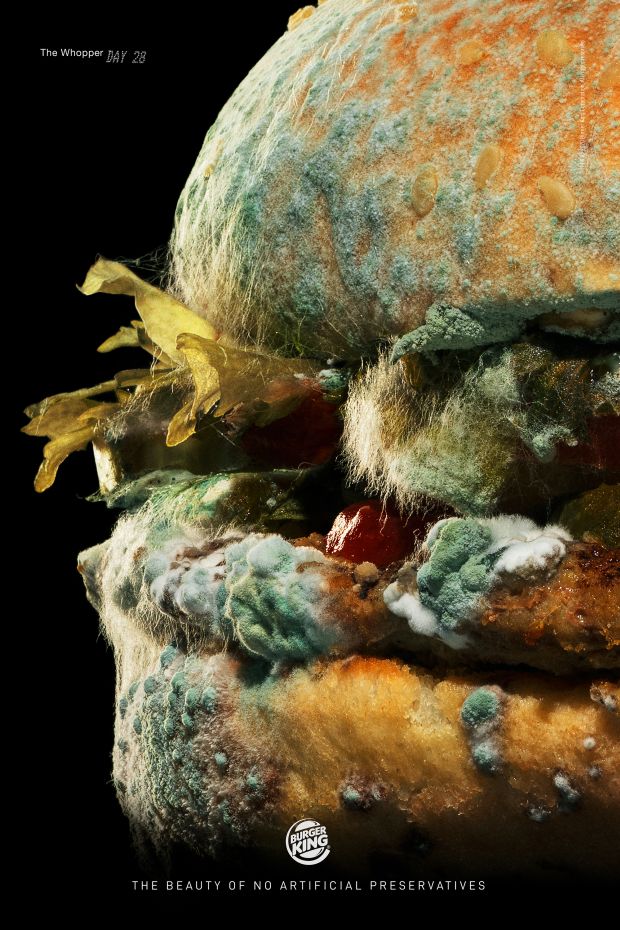“I Asked for Extra Mould on Mine!” The Ad Industry’s Flaming Hot Takes on ‘Moldy Whopper’
Burger King’s stunt has split opinion but everyone’s talking about it, writes Little Black Book editor Laura Swinton
Yesterday, Burger King dropped the ‘Moldy Whopper’, a campaign designed to trigger one of our most hardwired disgust responses while communicating a very positive message for the brand. Its flagship burger, The Whopper, is now created (in most of Europe and some of the US) with zero artificial ingredients – which means that, unlike that of its big, clown-themed competitor, the Whopper goes mouldy and decomposes.
At a time when people are more switched on about the contents of their food – and following some popular news stories in 2019 that showed McDonald’s burgers that had stayed closed to pristine for 10 years (Iceland) and 20 years (Utah) – it seemed like a perfect time for the punchy fast food chain to show off its natural credentials. To that end, they (together with the three agencies that individually pitched the idea over the past three years, Publicis Romania/Spain, INGO Sweden and DAVID Miami), created a campaign that sees the burger go putrid over 30 days. There’s a time lapse video and some intriguing close-up photography that turn the mouldy burgers into alien art.
And, woof. Has this campaign got people talking, or what?
The ad industry has been debating the campaign in offices and across social media. Outside the bubble, though, while the campaign has proven to be a hit with mainstream consumer press, there’s uncertainty about whether the work will have the desired effect with the public. After all, a visceral aversion to rotten food is a protective reaction that we’ve evolved over millennia. Can clever creative supersede that?

“The bravest and most creative pack-shot in advertising history. Perhaps.”
These days, creative-turned-director Ed Morris is usually reluctant to come out for or against a piece of advertising creative. But with Burger King being as brave as creatives so often wish clients were, he’s been moved to comment. In a sector where the product is so often primped and plumped by food stylists, it takes guts to show one’s products in a less-than-appealing light. He reckons the still element of the campaign is “the bravest and most creative pack-shot in advertising history. Perhaps.”
“I don’t comment on advertising much any more but I think that Burger King’s mouldy ad is probably the best and bravest thing to have run in the last 20 years. I don’t know how you would beat it. It’s an incredibly compelling truth laid bare as bare can be,” he says. “It’s a perfect example of the appropriation of creativity in advertising for competitive advantage. As far as ads go it’s a flaming Whopper.”
That bravery is something that Chuck McBride, founder and CCO of San Francisco-based agency Cutwater, also admires. “I really liked how brave it was to show a rotting burger as a way to talk about no artificial ingredients or preservatives,” he says.
Creatively the campaign has got a lot of fans. The strength and timeliness of the idea is reflected in the fact that Burger King was approached on three separate occasions by three different agencies with the idea.
Mark Denton is a creative and director who says the ad immediately stood out to him “It’s like a proper piece of advertising (at last)… without any unnecessary box-ticking except the one marked ‘GOOD IDEA’.”
“I do hope that it was created in the first place as a way to sell more burgers as opposed the cleaning up on the awards circuit but either way they’ve ended up with a stonking advert. Only time will tell if it’s a commercial success (I don’t care if it wins a trophy),” says Mark, who says that seeing the ad did make him consider getting a cheeky Whopper.

1 Comment
I’m lovin’ it.